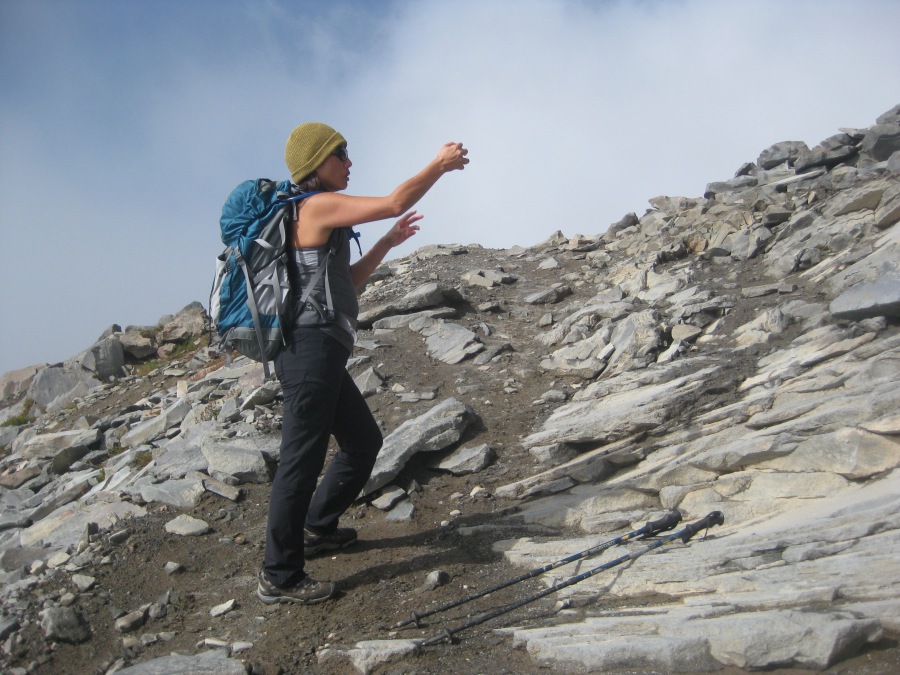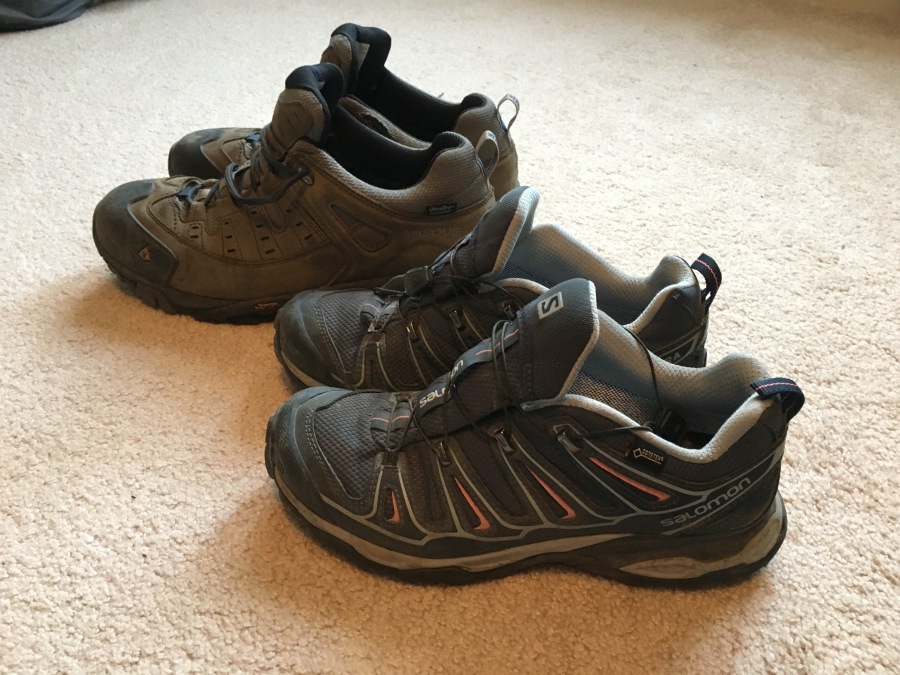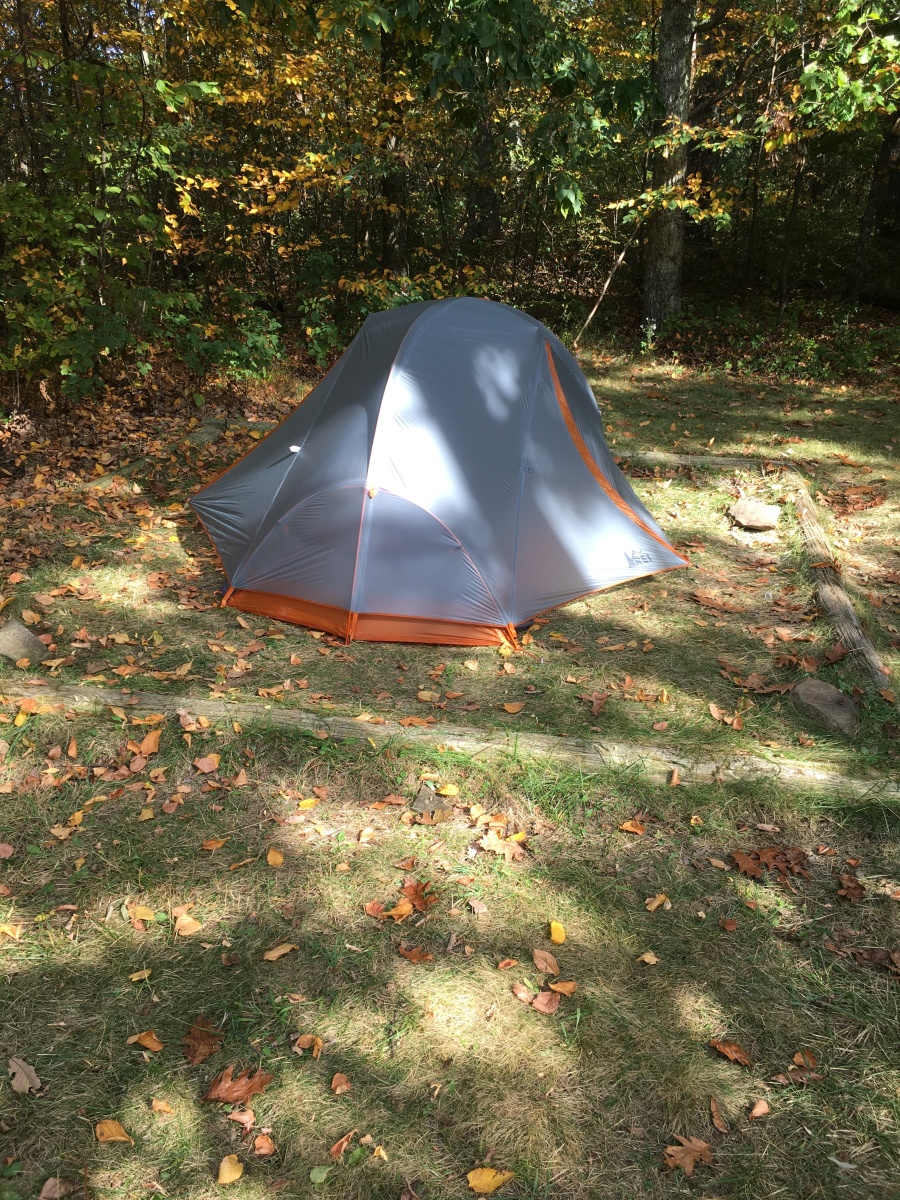The Three Essentials
The three widely agreed upon main hiking essentials are footgear, tent and sleeping bag. All require considerable forethought and investment, and a failure of any will result in serious consequences for a hiker.

Footgear: Shoes or boots or Fast Hikers. This is the most important gear purchase you will make, so chose well. Don’t skimp but don’t spend frivolously. If something isn’t working be quick you admit you made a mistake; take them back to the store and try something else. And if you get a pair that works, stick with them, and don’t let anybody tell you you’re wrong
Like most serious hikers, Brian started out with completely inadequate shoes; moved on to lumbering, armored, waterproof hiking boots that cost a lot; and have since gravitated toward lighter, cheaper, more disposable hiking shoes.
Shoes are very much an individual thing. Some people will want the extra protection that boots will give them. Some people like having ankle support, some don’t need it. Some are entirely comfortable hiking with wet feet and others are unable to.
Note that there is no such thing as ‘breaking in’ modern hiking shoes. The term ‘breaking in’ comes from the old days when shoes were made of stiff leather that literally had to be stretched and broken to accommodate the feet.
Most modern hiking shoes are not made mostly (if at all) of leather; they won’t ‘break in.’ Instead, they will rub your feet raw until either a callous forms on the skin, or friction rubs away the part of the shoes that was in contact with your feet. Neither is a desirable outcome. A good pair of modern shoes should feel good straight out of the box. There may be a minimum of friction on the first few hikes as your feet get used to the shoe, but thereafter there should be none at all. If a pair of shoes leaves your feet in unusual pain after the first hike, take it back immediately. If hot spots are still appearing after three or four outings, get rid of the shoes. It won’t get better. Cut your losses and move on, and don’t buy that shoe again.
A few points about shoes before moving on:
- Don’t cut corners with shoes; spend the money here and scale back elsewhere if you need to
- With that said, don’t get conned into spending $200 on a pair of shoes. You really don’t need to.
- Most serious hikers are now using lightweight trail shoes (effectively sneakers) over old-fashioned high-top boots. Doesn’t mean YOU have to, but be aware that this is the trend and it ain’t because hikers are slaves to fashion.
- Remember the old military maxim that a pound on the foot is worth five on the back.
- Lightweight hiking shoes fall to pieces MUCH faster than leather or gore-tex boots, and most serious hikers are willing to accept this since such shoes are generally cheaper.
- Waterproof hiking shoes aren’t of much use if they don’t cover the ankle (if water can run in through the top of the shoe, it will turn them into waterproof teacups, basically.)
- A good grip on the bottom of a shoe is preferable to busting your bottom
- Don’t get conned into buying boots that aren’t right for you by enthusiastic, well-meaning and entirely impartial commissioned sales people at major outdoor retailers. These salespeople are uncannily good at telling you what works for their feet, or somebody else’s feet. Remember, YOU OWN YOU FEET! You know what is best, not some guy in a green vest.
- If you are going to be doing a lot of hiking, getting a boot or shoe that is slightly bigger than your size should be considered. Your foot can increase a whole size (or more) while thru hiking.
- Orthotic insoles like Super Feet can REALLY make a difference. But they also aren’t cheap. Seek the advice of an orthopedic specialist.
- Socks are also very important in keeping your feet blister free; experiment with different types and strongly consider sock liners.
- NEVER go walking for a long way with a brand-new pair of shoes.
- One last note about shoes…expect to replace them regularly. If you do a lot of hiking you can easily go through more than one pair a year.

Gimme Shelter
This is another important area and one where it does not pay to skimp. The trend since the 1980’s has been to go ultra-lightweight; most modern backpacking tents are smaller and weigh a fraction what the army surplus and Boy Scout specials of yesterday did. This trend is not likely to reverse any time soon, so long as disposable income remains high and human beings remain upright walking vertebrates.
Our advice is threefold…
- Figure out how much room you need
- Figure out how much you are willing spend
- Buy the lightest weight tent practical that vectors #’s 1 and 2
MSR, Big Agnes, Mountain Hardwear, REI and many other companies now make outstanding lightweight tents and bivy sacks. Not all of these tents are extremely expensive, but none of them are cheap. Generally speaking, the lighter the weight, the pricier. If you are paying less than $200 for a shelter, you are either getting a good deal or a raw one. Chose carefully…a tent is not something you want to replace every year or two.

Here’s some more in-tents advice (get it? In-tents?)
- If you can only spend money on one thing, make this that one thing
- Don’t break the bank for your first tent purchase. Build the empire slowly. You can spend a ton of money here if that is what you want to do, but remember, a tent is just one component of many.
- Small solo tents and bivy’s are ‘wicked small’ as we say in Boston; so if you are not a wicked small person, or you have a lot of wicked good gear, make sure you can actually fit yourself and all your stuff into the shelter wicked comfortably.
- We would recommend a tent that does NOT require pegging out to the ground with ropes; free standing tents are more easily set up and can be moved after setup.
- If you REALLY want to go lightweight invest in a tarp, but make sure it’s right for you first.
- Any shelter that requires a tree, hiking pole or other appendage to make it stand up is likely to fail in adverse conditions. Just sayin’.
- Some people sleep in hammock-shelters, but this obviously requires a convenient pair of trees.
- Most lightweight, space age fabrics are super-wimpy. Thin materials tear easily, teeny zippers jam and break, they melt near fires. Keep this in mind when you purchase.
- The more you spend on a shelter, the wimpier it is likely to be (The extra cost is the weight reduction.)
- A tent with doors in both sides could be real useful, especially if say a bear were to come through one of the doors in the middle of the night.
- Storing a wimpy space aged shelter the correct way is VERY CRITICAL or else the whole thing will dissolve into mush in just a few years. Read up on this.
- ALL TENTS, REGARDLESS OF QUALITY, MUST BE FIELD TESTED BEFORE DEPLOYMENT. They also should to be tested at the beginning of each season. The time to figure out a tent is leaking is not when you are 20 miles from a road, at 10,000 feet, in a freezing downpour. (NOT that this would ever happen to Brian, of course.)
Sleeping Bag
Also known as the ‘you’ bag. Remember it’s not the bag that keep you warm, it’s you that keeps the you bag warm.
A sleeping bag, like a tent, is generally a big-ticket item, whose ticket might start at $120 for a low-end model and go up from there. Our advice here, like always, is to start small and build the empire slowly. There is no sense spending $600 on an expedition grade bag if you’re not going to be doing the kind of expeditions where you get your picture in National Geographic…unless you simply have that kind of money lying around and WANT to spend it.
There are a LOT of words out there in the public domain already on bags, so we’ll stay real high level.
Bags fall into two classes…down and synthetic.
Down bags are filled with feathers. Geese and ducks have evolved a perfectly good lightweight insulation technique over millions of years, and down bags take full advantage of this finely honed avian system. Down is very lightweight, very warm (if dry) and very easily compressed. The major drawback of down is that it reacts poorly to moisture; when wet, feathers clump into a big ball and lose their insulating ability. They are also a bitch to dry out. Other issues with down are the difficulty in caring for down products, and the cost.
Despite the drawbacks, most seasoned backpackers like down.
Synthetic bags are basically any type not made with feathers. Instead they utilize man-made insulating materials, usually some sort of polyester. Men have been doing the lightweight insulation thing for less long than geese have, and so the results to this point are somewhat mixed.
The biggest plus to synthetic bags is that they insulate well even when wet, and dry out fairly quick, making them a good choice for damp conditions. The historic downside of synthetic bags is that they are not as warm as down per the amount of material/money spent. They also tend to be stiff and difficult to compress (our biggest issue with them.)
Synthetic bags have improved over the years, but it is still a true statement that to get one which approaches a down bag for light weight, insulating ability and comfort, you usually pay a lot more than the equivalent down bag would cost.
Despite the notable advantage of performance in damp conditions, most hikers still prefer down bags over synthetic ones (as we do.) However, the difference between them is much less marked than it was ten years ago, and improves every year with better materials. It is likely that at some point, synthetic bags will replace down ones entirely.
Some notes about bags:
- If you have strong allergic reactions to feathers, dust, mold, and various other things that occur in nature, then a synthetic bag may well be the best option for you
- The temperature rating of a bag is a generalization only…a 35 degree rating does not mean YOU will be comfortable in that bag at 35 degrees. What it does mean is that bag is warmer than a bag rated 45 degrees but less warm then one rated 25 degrees
- Tolerance of cold varies greatly from person to person
- Women in general tend to be colder at rest than men, and most bag ratings now reflect this
- They make special bags these days for women and men, side sleepers and back sleepers, left and right handed people, etc. My advice is, don’t worry too much about this until you have been doing it long enough to know what YOU require
- A bag that is roomy not only will be more comfortable, it will insulate better
- A bag liner (a kind of thin sleeve for your body) is a good investment, they help keep your bag clean and can add 10-15 degrees of insulation
- Our advice for a novice hiker would be to invest in an affordable bag with a rating of 25-35 degrees. That will handle 95% of what is likely to be encountered from spring to fall in the lower 48.
- If you do a lot of winter camping, our advice would be to invest in a second, heavier bag specifically for those conditions, but use the lighter one the rest of the year.
- Best not to store your sleeping bags compressed in their stuff sacks, put them in an old pillow case or cloth sack.
- ESPECIALLY with down, dry and air your sleeping bags prior to storage
- Read up on the care of down bags. It’s almost a science.

